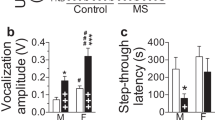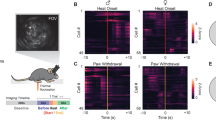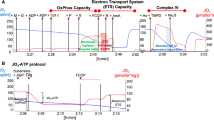Abstract
Corticotropin-releasing hormone (CRH) is centrally involved in coordinating responses to a variety of stress-associated stimuli. Recent clinical data implicate CRH in the pathophysiology of human affective disorders. To differentiate the CNS pathways involving CRH and CRH receptor 1 (Crhr1) that modulate behavior from those that regulate neuroendocrine function, we generated a conditional knockout mouse line (Crhr1loxP/loxPCamk2a-cre) in which Crhr1 function is inactivated postnatally in anterior forebrain and limbic brain structures, but not in the pituitary. This leaves the hypothalamic-pituitary-adrenocortical (HPA) system intact. Crhr1loxP/loxPCamk2a-cre mutants showed reduced anxiety, and the basal activity of their HPA system was normal. In contrast to Crhr1 null mutants, conditional mutants were hypersensitive to stress corticotropin and corticosterone levels remained significantly elevated after stress. Our data clearly show that limbic Crhr1 modulates anxiety-related behavior and that this effect is independent of HPA system function. Furthermore, we provide evidence for a new role of limbic Crhr1 in neuroendocrine adaptation to stress.
This is a preview of subscription content, access via your institution
Access options
Subscribe to this journal
Receive 12 print issues and online access
$209.00 per year
only $17.42 per issue
Buy this article
- Purchase on Springer Link
- Instant access to full article PDF
Prices may be subject to local taxes which are calculated during checkout






Similar content being viewed by others
References
Owens, M.J. & Nemeroff, C.B. Physiology and pharmacology of corticotropin releasing factor. Pharmacol. Rev. 43, 425–473 (1991).
Holsboer, F. The rationale for the corticotropin-releasing hormone receptor (CRH-R) antagonists to treat depression and anxiety. J. Psychiatr. Res. 33, 181–214 (1999).
Brunson, K.L., Avishai-Eliner, S., Hatalski, C.G. & Baram, T.Z. Neurobiology of the stress response early in life: evolution of a concept and the role of corticotropin-releasing hormone. Mol. Psychiatry 6, 647–656 (2001).
Avishai-Eliner, S., Brunson, K.L., Sandman, C.A. & Baram, T.Z. Stressed-out, or in (utero)? Trends Neurosci. 25, 518–524 (2002).
Caldji, C., Diorio, J. & Meaney, M.J. Variations of maternal care in infancy regulate the development of stress reactivity. Biol. Psychiatry 48, 1164–1174 (2000).
Liu, D. et al. Maternal care, hippocampal glucocorticoid receptors, and the hypothalamic-pituitary-adrenal response to stress. Science 277, 1659–1662 (1997).
Zobel, A.W. et al. Effects of the high-affinity corticotropin-releasing hormone receptor antagonist R121919 in major depression: the first 20 patients treated. J. Psychiatr. Res. 34, 171–181 (2000).
Timpl, P. et al. Impaired stress response and reduced anxiety in mice lacking a functional corticotropin-releasing hormone receptor 1. Nat. Genet. 19, 162–166 (1998).
Preil, J. et al. Regulation of the hypothalamic-pituitary-adrenocortical system in mice deficient for CRH receptors 1 and 2. Endocrinology 142, 4946–4955 (2001).
Müller, M.B. et al. Selective activation of the hypothalamic vasopressinergic system in mice deficient for the corticotropin-releasing hormone receptor 1 is dependent on glucocorticoids. Endocrinology 141, 4262–4269 (2000).
Dunn, A.J. & Berridge, C.W. Physiological and behavioral responses to corticotropin-releasing factor administration: is CRF a mediator of anxiety or stress responses? Brain Res. Rev. 15, 71–100 (1990).
Sillaber, I. et al. Enhanced and delayed stress-induced alcohol drinking in mice lacking functional CRH1 receptors. Science 296, 931–933 (2002).
Liebsch, G. et al. Chronic infusion of a CRH1 receptor antisense oligodeoxynucleotide into the central nucleus of the amygdala reduced anxiety-related behavior in socially defeated rats. Reg. Peptides 59, 229–239 (1995).
Smith, G.W. et al. Corticotropin releasing factor receptor 1-deficient mice display decreased anxiety, impaired stress response, and aberrant neuroendocrine development. Neuron 20, 1093–1102 (1998).
Joels, M. & de Kloet, E.R. Control of neuronal excitability by corticosteroid hormones. Trends Neurosci. 15, 25–30 (1992).
Korte, S.M., Korte-Bouws, G.A., Koob, G.F., De Kloet, E.R. & Bohus, B. Mineralocorticoid and glucocorticoid receptor antagonists in animal models of anxiety. Pharmacol. Biochem. Behav. 54, 261–267 (1996).
Korte, S.M. Corticosteroids in relation to fear, anxiety and psychopathology. Neurosci. Biobehav. Rev. 25, 117–142 (2001).
Tronche, F. et al. Disruption of the glucocorticoid receptor gene in the nervous system results in reduced anxiety. Nat. Genet. 23, 99–103 (1999).
Lewandoski, M. Conditional control of gene expression in the mouse. Nat. Rev. Genet. 2, 743–755 (2001).
Minichiello, L. et al. Essential role of trkB receptors in hippocampus-mediated learning. Neuron 24, 401–414 (1999).
Solà, C., Tusell, J.M. & Serratosa, J. Comparative study of the distribution of calmodulin kinase II and calcineurin in the mouse brain. J. Neurosci. Res. 57, 651–662 (1999).
Chen, Y., Brunson, K., Müller, M.B., Cariaga, W. & Baram, T.Z. Immunocytochemical distribution of corticotropin-releasing hormone type-1 (CRF1)–like immunoreactivity in the mouse brain: light microscopy analysis using an antibody directed against the C-terminus. J. Comp. Neurol. 420, 305–323 (2000).
Davis, M. & Whalen, P.J. The amygdala: vigilance and emotion. Mol. Psychiatry 6, 13–34 (2001).
Lobe, C.G. et al. Z/AP, a double reporter for Cre-mediated recombination. Dev. Biol. 208, 281–292 (1999).
Van Pett, K. et al. Distribution of mRNAs encoding CRF receptors in brain and pituitary of rat and mouse. J. Comp. Neurol. 428, 191–212 (2000).
Hascoet, M., Bourin, M. & Dhonnchadhda, B.A.N. The mouse light-dark paradigm: a review. Prog. Neurosychopharmacol. Biol. Psychiatry 25, 141–166 (2001).
Rodgers, J.I. & Dalvi, A. Anxiety, defence and the elevated plus-maze. Neurosci. Biobehav. Rev. 21, 801–810 (1997).
Cole, J.C. & Rodgers, R.J. Ethological comparison of the effects of diazepam and acute/chronic imipramine on the behaviour of mice in the elevated plus-maze. Pharmacol. Biochem. Behav. 52, 473–478 (1995).
Liebsch, G., Landgraf, R., Engelmann, M., Lorscher, P. & Holsboer, F. Differential behavioural effects of chronic infusion of CRH 1 and CRH 2 receptor antisense oligonucleotides into the rat brain. J. Psychiatr. Res. 33, 153–163 (1999).
Keck, M.E. et al. The anxiolytic effect of the CRH1 receptor antagonist R121919 depends on innate emotionality in rats. Eur. J. Neurosci. 13, 373–380 (2001).
Joels, M. Corticosteroid actions in the hippocampus. J. Neuroendocrinol. 13, 657–669 (2001).
Gray, T.S. & Bingaman, E.W. The amygdala: corticotropin-releasing factor, steroids and stress. Crit. Rev. Neurobiol. 10, 155–168 (1996).
López, J.F., Akil, H. & Watson, S. Neural circuits mediating stress. Biol. Psychiatry 46, 1461–1471 (1999).
Herman, J.P. & Cullinan, W.E. Neurocircuitry of stress: central control of the hypothalamic-pituitary-adrenocortical axis. Trends Neurosci. 20, 78–84 (1997).
Herman, J.P., Schafer, M.K., Young, E.A., Akil, H. & Watson, S.J. Selective forebrain fiber tract lesions implicate ventral hippocampal structures in tonic regulation of paraventricular nucleus corticotropin-releasing hormone (CRH) and arginine vasopressin (AVP) mRNA expression. Brain Res. 592, 228–238 (1992).
de Kloet, E.R. & Reul, J.M.H.M. Feedback action and tonic influence of corticosteroids on brain function: a concept arising from the heterogeneity of brain receptor systems. Psychoneuroendocrinology 12, 83–105 (1987).
Gesing, A. et al. Psychological stress increases hippocampal mineralocorticoid receptor levels: involvement of corticotropin-releasing hormone. J. Neurosci. 21, 4822–4829 (2001).
Raadsheer, F.C., Hoogendijk, W.J.G., Stam, F.C., Tilders, F.J.H. & Swaab, D.F. Increased number of corticotropin-releasing hormone expressing neurons in the hypothalamic paraventricular nucleus of depressed patients. Neuroendocrinology 60, 436–444 (1994).
Raadsheer, F.C. et al. Corticotropin-releasing hormone levels in the paraventricular nucleus of patients with Alzheimer's disease and depression. Am. J. Psychiatry 152, 1372–1376 (1995).
López, J.F., Chalmers, D.T., Little, K.Y. & Watson, S.J. Regulation of serotonine1A, glucocorticoid and mineralocorticoid receptor in rat and human hippocampus: implications for the neurobiology of depression. Biol. Psychiatry 43, 547–573 (1998).
Holsboer, F. The corticosteroid receptor hypothesis of depression. Neuropsychopharmacology 23, 477–501 (2000).
Hanks, M., Wurst, W., Anson-Cartwright, L., Auerbach, A.B. & Joyner, A.L. Rescue of the En-1 mutant phenotype by replacement of En-1 with En-2. Science 269, 679–682 (1995).
Hill, D.P. & Wurst, W. Screening for novel pattern formation genes using gene trap approaches. Methods Enzymol. 225, 664–668 (1993).
Kresse, A., Jacobowitz, D.M. & Skofitsch, G. Detailed mapping of CGRP mRNA expression in the rat central nervous system: comparison with previous immunocytochemical findings. Brain Res. Bull. 36, 261–274 (1995).
Acknowledgements
The authors would like to thank A. Nagy and C. Lobe for providing the Z/AP mouse line, G. Schütz for the antibody against Cre; M.E. Keck and C.T. Wotjak for critical reading of the manuscript, A. Yassouridis for statistical advice, and S. Alam, S. Bourier, C. Ehmann and B. Klaedtke for technical assistance. This work was partly supported by a grant from the Volkswagen Foundation (to F.H. and W.W.) and the Bundesministerium für Bildung und Forschung (BMBF, to W.W.).
Author information
Authors and Affiliations
Corresponding author
Ethics declarations
Competing interests
The authors declare no competing financial interests.
Supplementary information
Supplementary Fig. 1.
Plasma ACTH and corticosterone levels in female mice under basal conditions and following stress. '*' denotes statistical significance at α = 0.05. (PDF 17 kb)
Rights and permissions
About this article
Cite this article
Müller, M., Zimmermann, S., Sillaber, I. et al. Limbic corticotropin-releasing hormone receptor 1 mediates anxiety-related behavior and hormonal adaptation to stress. Nat Neurosci 6, 1100–1107 (2003). https://doi.org/10.1038/nn1123
Received:
Accepted:
Published:
Issue Date:
DOI: https://doi.org/10.1038/nn1123
This article is cited by
-
Prenatally traumatized mice reveal hippocampal methylation and expression changes of the stress-related genes Crhr1 and Fkbp5
Translational Psychiatry (2021)
-
Involvement of the ventral, but not dorsal, hippocampus in anxiety-like behaviors in mice exposed to the elevated plus maze: participation of CRF1 receptor and PKA pathway
Pharmacological Reports (2021)
-
Inhaled corticosteroids as treatment for adolescent asthma: effects on adult anxiety-related outcomes in a murine model
Psychopharmacology (2021)
-
Roles for androgens in mediating the sex differences of neuroendocrine and behavioral stress responses
Biology of Sex Differences (2020)
-
Forebrain excitatory neuron-specific SENP2 knockout mouse displays hyperactivity, impaired learning and memory, and anxiolytic-like behavior
Molecular Brain (2020)



